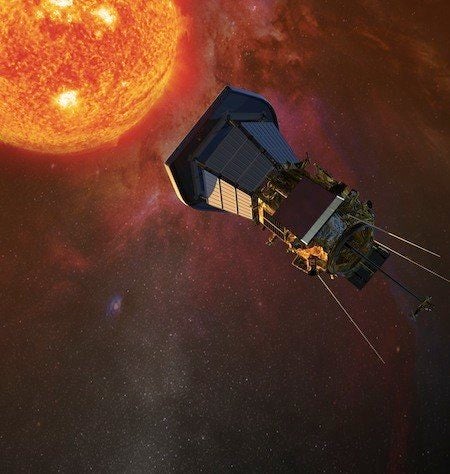
February 25, 2013
Of all the spacecraft humans have launched, there have been some impressively fast movers. But which holds the record?
It’s not an entirely idle question. Apart from the wow factor, it’s an interesting yardstick for gauging our capacity to explore the cosmos, from familiar planets to the icy depths of space.
However, as I quickly discovered in writing this post, it’s not always an easy quantity to evaluate. For one thing, launch velocities differ from eventual cruise velocities. And fancy interplanetary maneuvers like the ‘gravity assist‘ can provide temporary speed boosts that have to be taken into account.
It also depends on what you measure velocity relative to. Far away from the Earth it makes more sense to work with heliocentric (sun-relative) measurements. And (as you’ll see) you need not be zooming away into the void at all to reach the highest sustained speeds.
We can start off easy though. Launch velocity is something very definite, tuned to the finest level possible in order to insert a mission into its optimal trajectory. The record holder is also easy to find, it’s the New Horizons mission to Pluto and the Kuiper belt.
Launched by NASA in 2006, it shot directly to a solar system escape velocity. This consisted of an Earth-relative launch of 16.26 kilometers a second (that’s about 36,000 miles per hour), plus a velocity component from Earth’s orbital motion (which is 30 km/s tangential to the orbital path). Altogether this set New Horizons barreling off into the solar system with an impressive heliocentric speed of almost 45 km/s or 100,000 miles per hour.
The Sun’s pull is relentless though, so sometimes you need a helping hand. In 2007 New Horizons had slowed to about 19 km/s and made a flyby of Jupiter to snag a gravity assist (where the spacecraft ‘stole’ a tiny bit of Jupiter’s momentum) in order to regain about 4 km/s – before settling in for the long coast outwards. In the first figure shown here you can see how this is going to play out – heliocentric velocity is going to slowly drop during the journey through the Sun’s ever weakening gravity field. However, when it encounters Pluto, the spacecraft will still whizz by at about 14 km/s relative velocity.
This velocity profile is pretty typical, although quite simple. For comparison I’ve included a similar plot for Voyager 2′s trajectory (and it’s worth noting that Voyager 1 presently holds the record for highest velocity the furthest from the Sun, currently clocking a healthy 17 km/s or 38,000 mph).
The numerous gravity assists and course alterations in Voyager 2′s ‘Grand Tour’ of the solar system are writ large in its velocity history. Both Voyagers were able to build their escape route from the solar system while also taking in the sights – an incredible accomplishment.
But what about the other record holders? In terms of pure heliocentric velocity, the current champions are two probes called Helios I and II that were launched in 1974 and 1976. They entered orbits that took them closer to the Sun than the planet Mercury.
The nearer you orbit to a huge mass like the Sun the faster you have to move, and the Helios sisters moved very fast indeed. Both hit orbital velocities in excess of 70 km/s – or about 150,000 miles per hour.
But they’re not going to hold onto pole position for much longer.
First, NASA’s Juno mission to Jupiter will be arriving in the Jovian system in 2016 and will enter a polar orbit around the gas giant. But Jupiter weighs in at 317 times the mass of the Earth. Falling deep into its gravity well will accelerate Juno to a velocity of about 160,000 miles per hour relative to the planet, before it can swing by, drop speed, and get into its mission orbit.
In 2018 though, a new NASA mission – Solar Probe Plus – will be launched. Designed to come as close as 8.5 solar radii to the Sun (that’s about about 5.9 million kilometers or 3.7 million miles), it will hit orbital velocities as high as 200 kilometers a second (450,000 miles an hour).
To just put that incredible figure into perspective – going this fast would get you from the Earth to the Moon in about 1/2 an hour. It is also about 0.067% the speed of light.
It turns out that the fastest spacecraft do indeed go to the stars, in this case our nearest one.